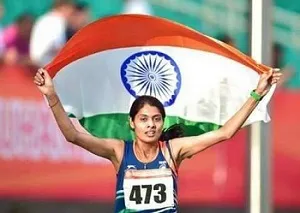Lalita Babar, India’s hope at Olympics, has been running all her life, leaping over barriers of fear and poverty
Why do athletes run competitively? For the pure high of winning? For the fame and acknowledgement that attends a winning effort? For the joy that comes from pitting yourself against the best in your field and coming out on top?

Lalita Shivaji Babar, only the third Indian woman to make an Olympics athletics final, began to run competitively for one reason, and one reason only -- because winning races brought in prize money, and that money was dearly needed to support her impoverished farmer family in Maharashtra's water-starved Satara district.
Well before she discovered that there was money, recognition, and maybe even a career in it, though, Lalita was a runner. She ran all the time -- obsessively, unstoppably, unnecessarily, just not competitively.
As a youngster, she ran -- not walked -- four kilometres every day to her school and back. As a teenager, she ran to faraway wells to fetch water for the 17 people that she shared a home with. She ran through the fields as she went about her chores on the farm. She ran barefoot and on all kinds of roads.
And in the middle of all this, she found time to run and chase at kho-kho games at school, because of course, it would be a poor life if you didn't make time for a sport in it.
Running for money
When she found out that competitive middle- and long-distance running could pay, she began to explore it more keenly, confident, after all those years of running, in her own skill and endurance. Her own family was supportive, but Lalita knew they were defying the village by allowing their daughter to run, and that travelling to competitions involved money that her family could ill-afford. The knowledge gave her feet wings -- if she won, she could pay her family back, both in money and a new-found respect from the village.
Her first big pay-cheque, Rs 10,000, came in 2004 when she won a 10-km road race at the age of 15. Lalita was ecstatic. She could make this work!
Coolly, rationally, she explored her options. She would run half-marathons and marathons because there was good money in them for the winner. She would participate in national-level athletics tournaments, but only to use them as a spring-board into international competitions, for as everyone knew, the government took care of athletes who won international prizes well, but didn't do enough for winners at the national level. Of her own ability to win those national competitions, she was never in doubt.
Lalita began to run with purpose. In 2009, she ran the 3000m in the Asian Indoor Games in Hanoi and finished eighth. Around that time, she was paired with tough Belarusian coach Nikolai Snesarev, who had been hired to coach Indian athletes for the Guangzhou Asian Games in 2010. With Snesarev, Lalita got to explore an event she had never tried before -- the weird and wonderful steeplechase.
Steeplechase was for men
The original steeplechase was an 18th-century rich man's sport, an Irish cross-country horse race, where horse and rider raced from 'church steeple to church steeple' (steeples being chosen as markers because of their visibility), clearing whatever obstacles they met on the way -- fences, streams, low stone walls.
A cross-country running race inspired by this sport eventually transitioned, in 1865, to a race across a flat field, where competitors cleared artificial barriers, and became an Olympic event in the very first modern games in 1896. Over seven laps, the 3000m race involves 28 barriers -- each, at 30 inches (in the women's event), as high as a typical dining table -- and seven water jumps -- each of which is about 12 feet long and has to be leapt across.
Strangely enough, the steeplechase was only a men's Olympic event until as recently as Beijing 2008, when the women's version was introduced.
Snesarev, who coached male athletes for the steeplechase, decided to try Lalita out for it. Just 10 days later, Lalita was hooked. This was the kind of cross-country running she was used to anyway -- she could be brilliant at it! But Snesarev quit right after the Guangzhou Games to take up a coaching assignment in Qatar, and Lalita, who still needed the money, went back to running marathons, winning the Mumbai Marathon three successive times -- in 2012, 2013, and 2014 -- and becoming a different kind of star in the bargain.
Breaking records
In January 2014, Snesarev returned to India to coach. He wanted to train her for the marathon, but Lalita insisted she wanted to try the steeplechase instead. Incredibly, just eight months after beginning serious training, she ‘podium-ed’ at the Incheon Asian Games, winning a bronze in the event at 9:35:37 and breaking the national record in the process.

Since that first glorious international win, breaking records has become something of a habit with Lalita.
At the 2015 Asian Championships, she won the gold and qualified for Rio, breaking the national record and the Games record with a timing of 9:34.13. Two months later, in the World Championships in Beijing, she finished eighth but broke the national record again, with a 9:27.86.
In April this year, she clocked 9:27:09 at the Federation Games in New Delhi, becoming, for a few short weeks, the holder of the best time in the steeplechase worldwide. On Saturday, Lalita stunned the country again, shaving an incredible seven seconds off her own national record to qualify for today's final with a time of 9:19.76.
If you go by statistics, you will declare that Lalita has no chance of a medal today -- after all, five athletes who placed ahead of her in the World Championships will be running alongside her at 7:45 pm IST, including Ruth Jebet, the Kenyan in Bahrainian colours who won gold in Incheon and has posted sub-9 minute times in the recent past.
But Lalita Babar has been running all her life, leaping over the barriers of fear, poverty, dependence, and people that would frown upon girls who run. It will take more than a statistic to stop that kind of girl.
(Roopa Pai wrote this post originally on her Facebook wall)







